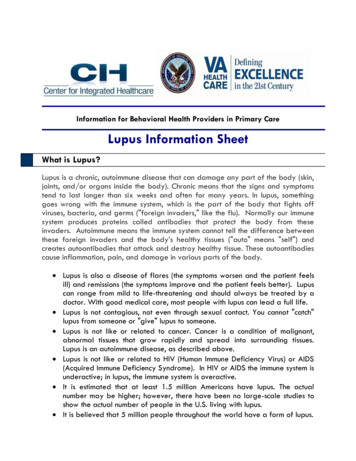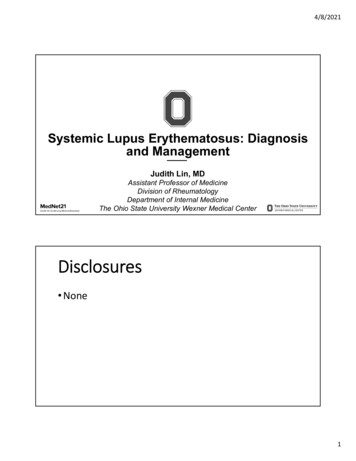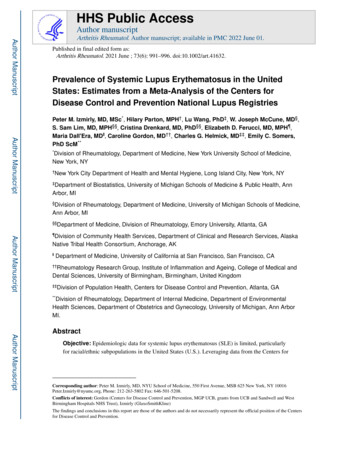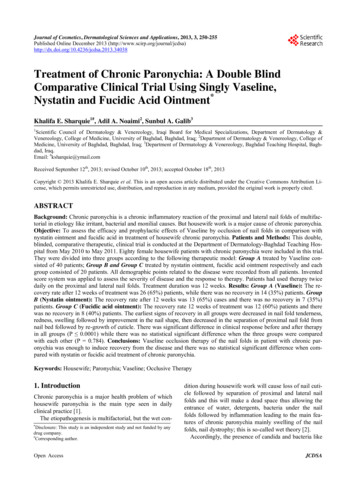
Transcription
LUPUS FOUNDATION OF AMERICA, INC.Lupus, the PrototypicalAutoimmune Disease,and the Military20092121 K STREET, N.W. SUITE 200, WASHINGTON, DC 20037
Overall, lupus annually costs the nation anestimated 31.4 billion in direct and indirectexpenditures. The average cost per person withlupus (between the ages of 18 and 65) wasestimated to be 20,924, although the cost oflupus kidney disease is much higher at 64,195iiand since lupus kidney disease represents about40% of the total lupus population, overall directand indirect costs may well exceed 31 billion.LUPUS, THE PROTOTYPICALAUTOIMMUNE DISEASE, AND THEMILITARYIntroduction:Lupus is the prototypical autoimmune diseasebecause it can affect any organ system or tissue inthe body. Many experts believe that research onlupus may provide important clues tounderstanding other autoimmune diseases. Inlupus, the body’s own immune system becomesunbalanced and incapable of differentiatingbetween foreign substances and its own cells andtissues. In essence, the body attacks itself, causinginflammation, pain and damage to the skin, joints,heart, lungs, blood system, kidneys and brainresulting in significant disability or death.In 2009, as many as 20,000 active duty soldiers andveterans are receiving care for lupus throughTRICARE or the Veteran’s Administrationhealthcare system. At this time, we do not havestatistics on the number of spouses or familymembers receiving treatment for lupus in thesetwo federal programs.Key factors in lupus:According to a 2002 National Institutes of Health(NIH) report, lupus and other autoimmunediseases affect an estimated 14 to 22 millionpeople in the United States. The estimated numberof individuals with lupus in the U.S. is between 1.5and 2 million.i To put these numbers intoperspective, cancers of all types affect anestimated 9 million Americans.While the causes of lupus are not fully known, it iswidely accepted that lupus results from a complexinteraction of genes and environmental factors. Inrecent years, a number of genes have been foundto play a role in the development of lupus. As well,environmental factors, such as hormonal andoccupational exposures, ultraviolet light, mentaland physical stress, infectious agents, chemicalsand toxins and certain drugs are known to triggerthe onset of lupus as well as the exacerbation ofexisting disease.2 Ninety percent of people with lupus arewomen (The number of women in themilitary is projected to rise - the number ofwomen veterans is expected to reach 1.8million in FY 2010) iii Lupus is two to three times more commonamong African Americans, Hispanics, AsianAmericans and Native Americans than inCaucasians – a health disparity thatremains unexplained iv (38% of all activeduty military women are minority womenMinority women account for 55% of Armyenlisted women) African-American women with lupus areimpacted at an earlier age, experiencegreater disease severity, have the highestoverall death rate among all people with
lupusv (30% of all active duty women areAfrican-American) prevent certain diseases, such as lupus, but tounderstand that clinical expression of a givendisease may occur after military service.xiiiEighty percent of new cases are diagnosedin women of child-bearing age – strikingpeople in their prime (This is also the timewhen women enter the military) More than 36% of lupus deaths occur inpeople between the ages of 15-44 vi(theaverage patient in the U.S. is diagnosed intheir 20’s and 30’s) According to the CDC, African-Americanwomen are three times more likely to diefrom lupus than Caucasian women viiVaccinations May TriggerAutoimmunityIn April of 2003, a 22-year old female soldier dieddue to lung complications caused by an acuteattack of previously undiagnosed lupus.xiv Anexpert medical panel concluded that the soldier’sdeath was precipitated by the administration offour pre-deployment vaccines – smallpox- typhoid,anthrax, hepatitis B and measles-mumps-rubella.Because of the complex nature of lupus, it is notuntypical for women of this age to haveundiagnosed lupus.Emerging research data indicates that our U.S.servicemen and women may be at high risk fordeveloping lupus and other autoimmune diseases.Factors such as post-traumatic stress disorder(PTSD)viii, vaccinesix, chemical and toxins,ultraviolet light, certain drugs and infectiousagents x xi xii have been associated with thedevelopment of lupus and other autoimmunediseases.According to the Centers for Disease Control andPrevention (CDC), individuals with compromisedimmune systems, such as lupus patients, shouldnot receive live-virus vaccines, or, importantly, beexposed to anyone who recently received a livevirus vaccine, such as for smallpox.Many issues regarding the health effects ofvaccines have been raised including thosesurrounding the potential health effects ofmultiple vaccines given prior to deployment.Few studies have been initiated to examine theseissues in depth. As the prototypical autoimmunedisease, findings from a robust research effort onlupus may provide clues to the causes of manyother autoimmune diseases. There is an urgentneed to expand research to better understand thekey factors that place military personnel at riskfor developing lupus.In addition, a Department of Defense (DoD) reportindicates that during the administration of theanthrax vaccine to hundreds of thousands of activeduty personnel, there were 147 events classified asserious or medically important.xv Lupus andundifferentiated immune affects were citedamong the adverse events.With respect to environmental exposures in thewar theaters today, several recent studies reportthat immune pathology may be present for adecade before the clinical presentation of lupus.Therefore, it will be important to recognizeenvironmental exposures today, not only toThere has also been much controversy as towhether squalene-containing adjuvants, as part ofthe anthrax vaccine formulation, were present inthe shots administered to military personnel.xvi3
Adjuvants are substances added to the vaccine toboost the immune response to the vaccine. Inanimal models, squalene has been used to induceantibodies and precipitate diseases that simulateautoimmune diseases such as lupus and MS. DoDhas asserted that squalene was not added to theanthrax vaccine; but, in subsequent tests, traces ofsqualene were found.experienced by veterans of both Gulf Wars.Neither clinical examination of ill war veterans orspecific scientific research has yielded conclusiveanswers about toxic exposure. In all reports on thematter, there is a clarion call for a more robustmedical research effort to expand presentknowledge of environmental hazards and theimpact on the health of our active duty personnelas well as the lasting effects on our veterans.To avert the potentially serious consequences of“live-strain” vaccines in immune compromisedindividuals, it would be important to identify lupusprior to the administration of vaccines. This isespecially relevant since lupus is widely underdiagnosed in the U.S. and underlying disease canbe triggered as a result of the use of thesevaccines.The National Academy of Sciences Institute ofMedicine (IOM) has completed studies in whichthey document illnesses related to environmentalexposures but additional research is urgentlyneeded since, as they state, “none of the identifiedtoxicological risks have been completely ruled outas possible causes of ill health among veterans.”xviiiResearch to detect servicemen and women whomay have underlying disease is urgently needed.According to lupus experts, an approach thatincludes the identification and validation of lupusbiomarkers and development of a test to detectthose markers should be initiated. A biomarker is achemical, physical or biological indicator, such ascholesterol, blood pressure or heart rate, whichcan be used to diagnose disease, measure theprogress of disease or monitor/assess the effectsof treatment. Existing lupus research hasprovided exciting clues about potential lupusbiomarkers but research to validate thesemarkers requires further study.Reports in the literature suggest during the firstGulf War, as well as in Iraq and Afghanistan,exposure to a cocktail of environmental chemicaland toxins may have caused a variety of conditionsincluding amyotrophic lateral sclerosis (ALS),multiple sclerosis (MS) and lupus.xix Along with the“dirty battlefield,” other health threats includedexposure to investigational vaccines for anthraxand other nerve agents. The release of sarin gasand related chemicals into the atmosphere duringbombing raids on Iraqi chemical-storage bunkershave been chronicled in various reports.A Department of Veteran’s Affairs study states that“further follow- up of Gulf War veterans and theircontrols is warranted for evaluating mortality riskof diseases with longer latency periods.” xxThe Persian Gulf Wars and Lupus (ToxicExposures)It is important to note that recent researchstrongly suggests that antibodies linked to lupusmay have latency periods that extend overdecades.Environmental and occupational factors have beenshown to both exacerbate lupus and trigger theonset of the disease.xviiToxic exposures have long been hypothesized tocause the majority of long-term health problems4
Current research has not clarified the variouscontributions of toxic exposures to development ofdiseases such as lupus. A more robust researcheffort to better understand the environmentalcontributions to the development of lupus isurgently needed.Ultraviolet Light, Certain Drugs and SmokingSunlight, specifically ultraviolet light, can triggerlupus rashes. In fact many people don’t get lupusuntil they have had bad sunburn. In recentdecades, most of operations theaters have been inhot, sunny climates.Other Related IssuesA variety of commonly used prescription drugs cantrigger lupus in genetically predisposed individuals.For example, sulfa antibiotics can trigger lupusflares. Other drugs known to trigger lupus are:hydralazine, procainamide, quinidine,carbamazepine, penicillamine, phenytoin, amongothers.Post-Traumatic Stress Disorder (PTSD)According to a recent report, troops sent to Iraqand Afghanistan who have post-traumatic stressdisorder (PTSD) are three times more likely todevelop lupus and other autoimmune diseases.xxiA 2005 Veteran’s Administration study states thatan estimated 10% of active duty women andretired military women who served in Iraq havePTSD. In addition, a New York Academy ofMedicine report states that Vietnam veterans whohave PTSD more commonly develop autoimmunediseases such as lupus.Smoking has also been linked to the worst form oflupus skin disease called discoid lupus.xxiiiConclusionsGrowing evidence suggests that there are factorsinvolved in military service that have the potentialto increase the risk of development of lupusamong servicemen and women. Individuals athighest risk for lupus are young, minority womenwhose ranks are growing in the military.Mental and physical stresses are known to affectthe neuroendocrine system whose function, inpart, is to quiet autoimmunity. In FY 2006, the topthree diagnostic categories for millions of womenveterans were PTSD, hypertension and depression.As we know, women, especially women of colorare at highest risk of developing lupus.xxiiAn expanded research program through theDepartment of Defense is urgently needed toanswer key questions related to the immuneresponse of military personnel when vaccines areadministered, when toxins and chemicals arepresent in the theaters of operation and whenpost-traumatic stress disorder occurs.Again, having validated lupus biomarkers and adefinitive test linked to those biomarkers wouldhelp to identify veterans with PTSD who are athighest risk for lupus. In this way, treatment forthe disease can be begun early to prevent thedisease from progressing and its associated costsfrom escalating.With respect to the administration of vaccines,knowing whether or not the soldier hasundiagnosed lupus or another autoimmunedisease is central to preventing morbidity andmortality associated with the disease. Presently,there is no way of identifying underlying lupus orautoimmune diseases in active duty personnel if5
clinical presentation of the disease has notoccurred.There are many gaps in our understanding of theadverse effects of vaccines on vulnerablepopulations. The case of the death of a 22-yearold female soldier given live-strain vaccines priorto her deployment to Iraq is particularly troublingsince the soldier had underlying lupus which couldnot be detected prior to the administration of thevaccines.Undiagnosed lupus is prevalent in the U.S.;therefore, the events which unfolded in this casecould very well be repeated not only in theuniformed services but in the general population.In addition, questions have been raised concerningthe interactions of multiple vaccines prior todeployment and in the field of operations whichshould be addressed by an expanded researcheffort. As well, the adjuvants which may have beenpresent in vaccine formulations have come underscrutiny.studies being conducted by federal agencies andinstitutions. In all of these reports there has been acall for a greatly expanded research effort tobetter understand the contributions ofenvironmental exposures related to diseasesdeveloped by active duty personnel and veterans.There is no better group to study than individualswith compromised immune systems because theymay in fact be the proverbial “canaries in the coalmine” providing early warning of the health effectsof various chemical and toxins present in theatersof operation.This is especially the case since recent studiesreport that immune pathology may be present fora decade before the clinical presentation of lupus.It will be important to recognize environmentalexposures in the war theaters today to not onlyprevent certain diseases, such as lupus, but tounderstand that clinical expression of a givendisease may occur after military service.In addition to the issues related to vaccines andtoxic exposure, there are other factors which maycontribute to the increased risk of developinglupus as a consequence of military service. Forexample, there is a three-fold increase inautoimmune diseases among military personnelwith PTSD. Early identification of lupus in thisgrowing population will be important to detect thedisease early in its course. This is especiallyimportant in lupus since the disease can progressto irreparable damage to single and/or multipleorgan systems of the body.Lupus is a complex disease which is difficult todiagnose. While there are multiple tests that canbe administered to detect lupus, these tests arenot definitive and must be interpreted by aknowledgeable physician. The identification andvalidation of lupus biomarkers, those physiologicmarkers which can help to detect disease, assessprogress of disease and monitor treatmenteffectiveness and the development of a definitivetest to detect those markers, could be invaluablein identifying military personnel with compromisedimmune systems who, according to the CDC,We believe that the identification and validation ofshould not receive vaccinations containing livelupus biomarkers and the subsequentdevelopment of a test to detect those markers willstrains.identify servicemen and women who can then beThe short and long term health effects ofprotected from the morbidity and mortalitychemicals and toxins on our active duty soldiersassociated with live strain vaccines. Biomarker andand veterans have been chronicled in reports andtest development will also be invaluable in6
identifying immune compromised individualsdiagnosed with PTSD. In addition, a robustresearch effort focused on immune compromisedindividuals and various toxic exposures is anapproach which has the potential to reliablyprovide information that will serve to protect thehealth of our veterans and as well as our nonveteran populations.The Lupus Foundation of America (LFA)The Lupus Foundation of America is the foremostnational voluntary nonprofit organizationdedicated to the fight against lupus. Our mission isto find the causes of and cure for lupus andprovide support, services and hope to all peopleaffected by lupus. The Foundation vigorouslypursues its mission through programs of medicalresearch, education and advocacy. Through itsnationwide network of more than 300 affiliates,chapters and support groups, the Foundationprovides assistance to the more than 1.5 millionpeople affected by lupus, their families andcaregivers. For more information about the LFA,visit our website at www.lupus.org or call202-349-1155.7
CITATIONSi.National Telephone Survey (Omnibus), Lupus Foundation of America, May, 1994, BruskinGoldring Research, Edison, New Jersey.ii.Direct and Indirect Costs to Employers of Patients with Lupus With and Without Nephritis,Ginger Carls, M.A., American College of Occupational and Environmental Medicine, Volume51, Number 1, January,2009.iii.Lupus Foundation of America, Estimates of Lupus Among Active Duty and Reserve MilitaryPersonnel, 2009.iv.The Epidemiology of Systemic Lupus Erythematosus, Dubois’ Lupus Erythematosus, 1997.v.National Institute of Arthritis and Musculoskeletal and Skin Diseases, Strategic Plan forReducing Health Disparities, November, 2006.vi.The Lupus Book, Daniel Wallace, M.D., 2009.vii.The Lupus Book, Daniel Wallace, M.D., 2009.viii.Centers for Disease Control and Prevention, Trends in Deaths from Systemic LupusErythematosus – United States, 1979-1998.ix.The New York Academy of Medicine, Vietnam Veterans Who Have Post-Traumatic StressDisorder Likely to Suffer from Autoimmune Disease, Joseph A. Boscarino, Ph.D.,M.P.H., 2003,and Post-Traumatic Stress Disorder and Physical Illness: Results from Clinical andEpidemiological Studies, Annals of the New York Academy of Sciences, 1032 (2004): 141153, and Stress as a Trigger of Autoimmune Disease, Ljudmila Stojanovich, AutoimmunityReviews 7 (2008): 209-213.x.Vaccines and Gulf War Illness, Department of Veterans Affairs, Report, 2008.xi.Gulf War Illness and the Health of Gulf War Veterans, Cholinergic and RelatedNeurotoxicants: Pryridostigmine Bromide, Pesticides and Nerve Agents, August, 2008.xii.Autoimmune Diseases Associated with Drugs, Chemical and Environmental Factors, DavidD’Cruz, Toxicology Letters 112-113 (2000): 421-432.xiii.Occupational and Environmental Exposures as Rick Factors for Systemic LupusErythematosus, Glinda S. Cooper, Christine G. Parks, Current Rheumatology Reports 6(2004): 367-374.8
xiv.Early Environmental Exposure and the Development of Lupus, CJ Edwards, M.D., C Cooper,Department of Rheumatology, Southhampton University Hospitals, UK and MRCEpidemiology Resource Center, University of Southhampton, UK, LUPUS (2006) 15: 814-819.xv.Female Soldier Dies after Receiving Vaccinations, Deborah Funk, Army Times, July, 2003.xvi.Safety of Anthrax Vaccine: A Review by the Anthrax Vaccine Expert Committee (AVEC) ofAdverse Events, JL Sever, George Washington University, School of Medicine,Pharmacoepidemiology Drug Safety, 2002, April-May: 11 (3): 189-202.xvii.Department of Veterans Affairs, Vaccines and Gulf War Illness, Report, August 2008.xviii.The Lupus Book, Daniel Wallace, M.D., 2009.xix.Institute of Medicine (IOM), Volumes I-IV, Gulf War and Illnesses, 2006.xx.First Gulf War Health Problems, Autoimmune Diseases, (author)xxi.Department of Veterans Affairs, Vaccines and Gulf War Illness, Report, August 2008.xxii.The New York Academy of Science, J. Boscarino, Ph.D., M.P.H., 2003 (See citation ix).xxiii.Department of Veterans Affairs, Women Veterans: Past, Present and Future, September2007.xxiv.Autoimmune Diseases Associated with Drugs, Chemicals and Environmental Factors, DavidD’Cruz, M.D., Toxicology Letters, 2000, See Citation ix.9
10
report states that Vietnam veterans who have PTSD more commonly develop autoimmune diseases such as lupus. Mental and physical stresses are known to affect the neuroendocrine system whose function, in part, is to quiet autoimmunity. In FY 2006, the top three diagnostic categories for millions of women veterans were PTSD, hypertension and .










